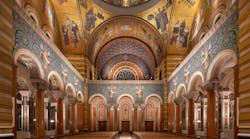Massive. Colossal. An icon of London. The Battersea Power Station, located on the bank of the River Thames, is one of the largest brick buildings in Europe. Designed by Sir Giles Gilbert Scott, its original construction, which required more than six million bricks, spanned from 1929 to 1955. For decades, the Battersea Power Station generated a significant portion of London’s electricity from burning coal, but in 1983, it was decommissioned and left abandoned. The structure remained derelict until the summer of 2013, when a $10 billion renovation and redevelopment project commenced. Today, this 42-acre Grade II* listed former industrial site is home to approximately 150 shops, cafes and restaurants, along with numerous offices and residences, making it one of London’s most extensive office, retail, residential, leisure and cultural sites.
Gazing up at the structure at close range, its magnitude inspires awe, like a great castle or fortress, yet the design is distinctly Art Deco. WilkinsonEyre served as project architect and Speirs Major led the lighting design for this epic project.
At night, the building’s façade, along with its four iconic chimneys, are illuminated with warm, golden light, highlighting its essential form and historic fabric. Speirs Major selected warm, golden light to reflect upon the building’s industrial heritage and to create a safe and welcoming atmosphere.
“The lighting of Battersea Power Station emphasises Sir Giles Gilbert Scott’s dramatic architectural design, from its intricate brick patterns to the world-famous soaring chimneys, which can now be seen across London at night when illuminated. The meticulous restoration work can also be enjoyed by all with carefully considered light placement designed to showcase the building’s embellished façade,” said Sam Cotton, head of asset management at Battersea Power Station Development Co.
For holidays and special events, DMX lights and i-2 RGBW POI fixtures by SGM Light illuminate the façade and chimneys, creating dynamic color schemes and animated light shows for maximum visual impact.
“The chimneys can be lit in a variety of different colours, which enables us to show our support for various cultural events and charity initiatives throughout the year,” said Cotton.
The walkways and gardens near the residential quarters are illuminated by 7.9W Vincenza 360 accent lights by Ares with a color rendering index (CRI) above 80 to reveal the rich green shades of the trees, hedges and other natural surroundings. The low-wattage lighting minimizes light spill for residents while creating a welcoming atmosphere.
“The welcoming atmosphere comes about through the use of warm white light and by making sure that light levels are kept low enough to give a sense of privacy, particularly towards the residential entrances, whilst still feeling safe and attractive,” said Clementine Fletcher-Smith, partner at Speirs Major. “Using bollards to position the light sources at a physically low level also helps by creating smaller pools of light with a more relatable scale alongside the enormity of the building, while the solid-looking pieces of metalwork still suit the scale and industrial character of the building.”
The two main entrances to the Battersea Power Station are illuminated by 36W, 3000K Monospot 3 spotlights by Meyer Lighting, atop thin, elevated light poles that are slim and simple in design.
Indoors, Speirs Major reinstated the original, period lighting while discreetly adding a layer of modern architectural lighting. A smart, connected system that utilizes the DALI-2 communication protocol controls the lighting across the entire site.
The vast Turbine Halls feature major new retail spaces. The goal of the lighting design in this area has been to create a vibrant shopping experience while celebrating the heritage of the original architecture. Four-color (RGBW) linear LED tubes and Lumenbeam LBX pendant lights by Lumenpulse illuminate the steelwork and tiled walls. Period skylights and light wells allow plentiful daylight into the spaces.
“In the retail spaces, the shop signage and displays provide the brightest lighting accents, so our design is focused on a gentle celebration of the shell of the building,” said Fletcher-Smith. “Some light fittings are a bit more expressive, such as the perimeter pendants in both Turbine Halls and the linear glowing lines in the mesh circulation spaces, which add to the character of those spaces when viewed against the backdrop of the huge surrounding volumes.”
“Inside the Power Station in Turbine Hall A, LED lighting adds to the natural light which pours through the central roof light and soaring windows to the north and south. Targeted lighting also emphasises the most decorative elements of the original faience tiling above the steel girders, drawing the eye upwards,” said Cotton. “In Turbine Hall B, natural light wells have been installed in place of the original fan vents that were once used for extracting smoke when the Power Station was operational. These permit the sun to brighten the Turbine Hall through the day, and LED lights are switched on inside the light wells during the evening and on overcast days. The light wells can also be changed to a spectrum of colours, adding a different ambiance to the more minimalist and industrial turbine hall for different occasions or events.”
The goal for lighting the control rooms was to enable these unique heritage spaces to be utilized for private gatherings and special events, while staying true to the original design intent.
“Inside the building, we continued to align the physical size and appearance of the light fittings with the industrial aesthetic, whilst also looking for opportunities to introduce light at a human scale,” said Fletcher-Smith. “The more private the spaces become, the closer people get to the light.”
Turbine Hall A houses the well-known Control Room A, which is now an events space. Built in the 1930s, this spectacular Art Deco style control room features beautiful wood parquet flooring, restored glass ceiling fixtures and skylights, and of course, the controls — an amusing assortment of gauges, dials, indicator lights, switches and buttons. The period lighting is discreetly augmented by 2700K ADL.CP Type X adjustable downlights by Stoane Lighting.
Control Room B, which overlooks Turbine Hall B, has been turned into an all-day cocktail bar. Originally built in the late 1940s, after World War II, the grey, industrial-style interior design is enlivened by Vaya color-changing LEDs by ColorKinetics. The bar itself, where patrons can order clever, power-station-themed cocktails such as “The Synchroscope” and “The Smoke Stack,” is designed to look like a gleaming, stainless-steel turbine.
Back outside the Battersea Power Station is a pedestrianized high street called Electric Boulevard that provides access to the London Underground. Electric Boulevard comprises Prospect Place, designed by Gehry Partners, and Battersea Roof Gardens, designed by Foster + Partners. Prospect Place hosts 308 apartments and a mix of retail, restaurants and leisure brands. Battersea Roof Gardens features 436 apartments, a mix of shops, restaurants and bars, and the much-anticipated art’otel London Battersea Power Station.
Battersea Roof Gardens also features a new 200,000-square-foot office space, known as 50 Electric Boulevard, due to be completed in early 2024. This highly sustainable office space, designed by Foster + Partners, is certified WELL Platinum and BREEAM Outstanding, and features biophilic design, which aims to connect building occupants with the natural environment. The roof of the building features a vast, beautifully landscaped garden with spectacular views of the Battersea Power Station, the River Thames and London’s cityscape. At night, the roof garden is illuminated with warm, golden light, and the view of London is magnificent.











